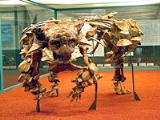
Saichania
Encyclopedia
Saichania is a genus
of ankylosaurid dinosaur
from the Late Cretaceous
period. It was found in the Barun Goyot Formation
at Khulsan in the Nemegt Basin, southern Mongolia
. It lived during the Campanian
. The type species is Saichania chulsanensis.
Saichania was described by Teresa Maryańska
in 1977, along with Tarchia
kielanae. The type specimen
of S. chulsanensis consists of a skull and the anterior
part of the postcrania
l skeleton (neck and back vertebrae, shoulder girdle, forelimb, and some armour
in life position). Referred specimens include a fragmentary skull roof
and associated armour, and an undescribed, almost complete skeleton with skull (see picture).
. These may have allowed the animal to cool the air that it breathed, and to eat tough plants, suggesting that it lived in a hot, arid, environment. There is even some evidence that the animal may have possessed a salt gland next to its nostrils, which would have further aided it in a desert habitat.
Genus
In biology, a genus is a low-level taxonomic rank used in the biological classification of living and fossil organisms, which is an example of definition by genus and differentia...
of ankylosaurid dinosaur
Dinosaur
Dinosaurs are a diverse group of animals of the clade and superorder Dinosauria. They were the dominant terrestrial vertebrates for over 160 million years, from the late Triassic period until the end of the Cretaceous , when the Cretaceous–Paleogene extinction event led to the extinction of...
from the Late Cretaceous
Late Cretaceous
The Late Cretaceous is the younger of two epochs into which the Cretaceous period is divided in the geologic timescale. Rock strata from this epoch form the Upper Cretaceous series...
period. It was found in the Barun Goyot Formation
Barun Goyot Formation
The Barun Goyot Formation , dating from the Late Cretaceous Period, is located within and is widely represented in the Gobi Desert basin, in the Ömnögovi Province of Mongolia....
at Khulsan in the Nemegt Basin, southern Mongolia
Mongolia
Mongolia is a landlocked country in East and Central Asia. It is bordered by Russia to the north and China to the south, east and west. Although Mongolia does not share a border with Kazakhstan, its western-most point is only from Kazakhstan's eastern tip. Ulan Bator, the capital and largest...
. It lived during the Campanian
Campanian
The Campanian is, in the ICS' geologic timescale, the fifth of six ages of the Late Cretaceous epoch . The Campanian spans the time from 83.5 ± 0.7 Ma to 70.6 ± 0.6 Ma ...
. The type species is Saichania chulsanensis.
Saichania was described by Teresa Maryańska
Teresa Maryanska
Teresa Maryańska is a Polish paleontologist who has specialized in Mongolian dinosaurs, particularly pachycephalosaurians and ankylosaurians. A member of the 1964, 1965, 1970, and 1971 Polish–Mongolian expeditions to the Gobi Desert, she has described many finds from these rocks, often with...
in 1977, along with Tarchia
Tarchia
Tarchia is a genus of ankylosaurid dinosaur from the late Cretaceous of Mongolia. It is currently the geologically youngest known of all the Asian ankylosaurid dinosaurs and is represented by five or more specimens, including two complete skulls and one nearly complete postcranial skeleton...
kielanae. The type specimen
Holotype
A holotype is a single physical example of an organism, known to have been used when the species was formally described. It is either the single such physical example or one of several such, but explicitly designated as the holotype...
of S. chulsanensis consists of a skull and the anterior
Anatomical terms of location
Standard anatomical terms of location are designations employed in science that deal with the anatomy of animals to avoid ambiguities that might otherwise arise. They are not language-specific, and thus require no translation...
part of the postcrania
Postcrania
Postcrania[p] in zoology and vertebrate paleontology refers to all or part of the skeleton apart from the skull. Frequently, fossil remains, e.g...
l skeleton (neck and back vertebrae, shoulder girdle, forelimb, and some armour
Armour (zoology)
Armour in animals is external or superficial protection against attack by predators, formed as part of the body , usually through the hardening of body tissues, outgrowths or secretions. It has therefore mostly developed in 'prey' species...
in life position). Referred specimens include a fragmentary skull roof
Skull roof
The skull roof , or the roofing bones of the skull are a set of bones covering the brain, eyes and nostrils in bony fishes and all land living vertebrates. The bones are derived from dermal bone, hence the alternative name dermatocranium...
and associated armour, and an undescribed, almost complete skeleton with skull (see picture).
Description
Saichania was a bulky, heavily armoured dinosaur with a maximum length of about 6.6 metres (21.7 ft) long. The armour on the top of its head and along its back and flanks were studded with large spikes, and it had a club-shaped tail. The skull had complex air passages, and an unusually solid hard palateHard palate
The hard palate is a thin horizontal bony plate of the skull, located in the roof of the mouth. It spans the arch formed by the upper teeth.It is formed by the palatine process of the maxilla and horizontal plate of palatine bone....
. These may have allowed the animal to cool the air that it breathed, and to eat tough plants, suggesting that it lived in a hot, arid, environment. There is even some evidence that the animal may have possessed a salt gland next to its nostrils, which would have further aided it in a desert habitat.

